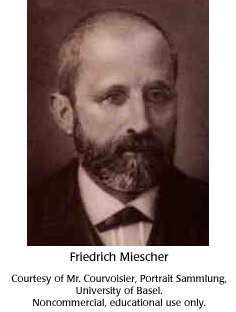Concept 15 DNA and proteins are key molecules of the cell nucleus.

 In 1869, Friedrich Miescher isolated "nuclein," DNA with associated proteins, from cell nuclei. He was the first to identify DNA as a distinct molecule. Phoebus Levene was an organic chemist in the early 1900's. He is perhaps best known for his incorrect tetranucleotide hypothesis of DNA.
In 1869, Friedrich Miescher isolated "nuclein," DNA with associated proteins, from cell nuclei. He was the first to identify DNA as a distinct molecule. Phoebus Levene was an organic chemist in the early 1900's. He is perhaps best known for his incorrect tetranucleotide hypothesis of DNA.
- Go to:
- Phoebus Levene (1869-1940)
Friedrich Miescher (1844-1895)

Friedrich (Fritz) Miescher was born in Basel, Switzerland. The Miescher family was well-respected and part of the intellectual elite in Basel. Friedrich's father was a physician and taught pathological anatomy; Friedrich's uncle, Wilhelm His, was a well-known embryologist.
Miescher was an excellent student despite his shyness and a hearing handicap. Miescher initially wanted to be a priest, but his father opposed the idea and Miescher entered medical school. When he graduated in 1868, Miescher ruled out specialties where patient interactions were necessary because of his hearing problem. He decided to base his career on medical research. He went to the University of Tübingen to study under Felix Hoppe-Seyler in the newly established faculty of natural science.
Hoppe-Seyler's laboratory was one of the first in Germany to focus on tissue chemistry. At a time when scientists were still debating the concept of "cell," Hoppe-Seyler and his lab were isolating the molecules that made up cells. Miescher was given the task of researching the composition of lymphoid cells — white blood cells.
These cells were difficult to extract from the lymph glands, but they were found in great quantities in the pus from infections. Miescher collected bandages from a nearby clinic and washed off the pus. He experimented and isolated a new molecule - nuclein - from the cell nucleus. He determined that nuclein was made up of hydrogen, oxygen, nitrogen and phosphorus and there was an unique ratio of phosphorus to nitrogen. He was able to isolate nuclein from other cells and later used salmon sperm (as opposed to pus) as a source.
Although Miescher did most of his work in 1869, his paper on nuclein wasn't published until 1871. Nuclein was such a unique molecule that Hoppe-Seyler was skeptical and wanted to confirm Miescher's results before publication.
Miescher continued to work on nuclein for the rest of his career. He also examined the metabolic changes that occur in salmon when they spawn. In 1872, Miescher was appointed the professor of physiology at the University of Basel, a position previously held by his father and then his uncle. The appointment meant more funds and equipment for research, but it also meant that Miescher had to teach. Although he put in a lot of time and effort, Miescher was not a good teacher. His shyness and preoccupation with his research made it difficult for him to relate to his students. He was a perfectionist and a workaholic, and often worked very long hours to do the nuclein isolations.
It would be years before the role of nucleic acids were recognized. Miescher, himself, believed that proteins were the molecules of heredity. However, Miescher laid the groundwork for the molecular discoveries that followed. Miescher died in 1895 from tuberculosis.


Phoebus Levene knew Ivan Pavlov — the physiologist who developed the idea of the conditional reflex by training dogs to salivate at the sound of a bell. On a visit to New York, Pavlov was mugged. It was Levene who helped Pavlov get home by providing money and a new visa.

Levene's tetranucleotide hypothesis is incorrect. What kind of alternate theories can you come up with to explain the structure of DNA?
 DNA and proteins are key molecules of the cell nucleus.
DNA and proteins are key molecules of the cell nucleus. One gene makes one protein.
One gene makes one protein. A gene is made of DNA.
A gene is made of DNA. Bacteria and viruses have DNA too.
Bacteria and viruses have DNA too. The DNA molecule is shaped like a twisted ladder.
The DNA molecule is shaped like a twisted ladder. A half DNA ladder is a template for copying the whole.
A half DNA ladder is a template for copying the whole. RNA is an intermediary between DNA and protein.
RNA is an intermediary between DNA and protein. DNA words are three letters long.
DNA words are three letters long. A gene is a discrete sequence of DNA nucleotides.
A gene is a discrete sequence of DNA nucleotides. The RNA message is sometimes edited.
The RNA message is sometimes edited. Some viruses store genetic information in RNA.
Some viruses store genetic information in RNA. RNA was the first genetic molecule.
RNA was the first genetic molecule. Mutations are changes in genetic information.
Mutations are changes in genetic information. Some types of mutations are automatically repaired.
Some types of mutations are automatically repaired.